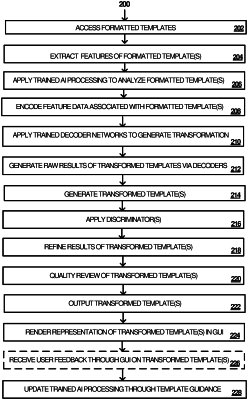| CPC G06F 40/186 (2020.01) [G06F 40/103 (2020.01); G06N 3/02 (2013.01); G06N 3/088 (2013.01); G06N 5/04 (2013.01); G06N 20/00 (2019.01); G06V 10/40 (2022.01)] | 20 Claims |

|
1. A method comprising:
extracting feature data for objects of a first slide-based template and feature data for visual style attributes of the first slide-based template, wherein the feature data for the objects comprises shape information for the objects, and wherein the first slide-based template is associated with a first presentation theme providing a first set of visual style attributes for the objects of the first slide-based template;
applying trained artificial intelligence (AI) processing, configured for generation of transformations of slide-based templates, to generate a transformation of the first slide-based template, wherein the applying of the trained AI processing executes processing operations that comprise:
encoding the feature data for the objects of the first slide-based template as a latent vector providing a distributed representation of the feature data,
propagating the latent vector to a first decoder network selected from a plurality of decoder networks, wherein each of the plurality of decoder networks is trained based on training data comprising data for slide-based templates having one of a plurality of different presentation themes, wherein the first decoder network is trained based on training data comprising data for slide-based templates having a second presentation theme of the plurality of different presentation themes, wherein the second presentation theme is different from the first presentation theme and provides a second set of visual style attributes for objects thereof, and
automatically generating a transformed template for the first slide-based template based on analysis of the latent vector using the first decoder network, wherein the transformed template comprises: one or more transformations of the objects of the first slide-based template and a style transformation modifying one or more visual style attributes of the first set of visual style attributes; and
storing the transformed template for subsequent presentation through a productivity service.
|